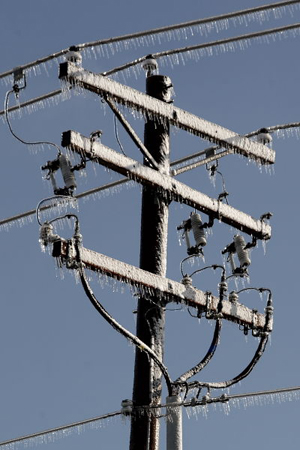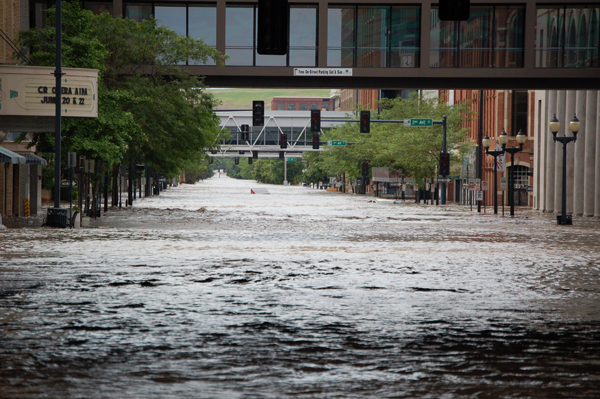By Jake Brooks, with contributions from Chee Chan, Elise Foong, Michael Nolan and Marvin Stemeroff of AECOM
When Hurricane Sandy knocked out major parts of the electrical grid along with other infrastructure previously considered relatively robust it was only the latest in a series of vivid illustrations of how climate change is affecting many experts’ view of how the planning for basic infrastructure needs to change. A number of grid planners and managers, along with generators, have begun rethinking their systems for investment planning to take account of increased risk posed by extreme weather events. In a report recently released by the U.S. White House, the annual cost to the US of weather related power outages was estimated at US$25 to $70 billion. The report, titled “Economic Benefits of Increasing Electric Grid Resilience to Weather Outages,” calls for major new grid investment to withstand storm-caused power outages (US Department of Energy 2013).

How are electric power generators in particular dealing with a changing climate and associated impacts on their business? No longer is the issue of climate change limited to procuring cleaner fuels and controlling the impact of a power station on the environment. Focus is now shifting to how the changing environment will impact generator output, as well as the infrastructure and facilities necessary for the generation of power. Power producers around the world, like many of those responsible for other kinds of major infrastructure, are reviewing their response and recovery management processes for extreme weather. As weather-related incidents have grown, attention is moving to greater preparation and “hardening” of assets and systems to manage increasing climatic risks.
Known as “Climate Change Adaptation,” this growing field examines how changing climatic conditions can be planned for and managed to increase system resilience to current and future extremes, and to better protect service delivery, operations and critical assets. It is destined to become part of ongoing business planning, some experts believe. Michael Nolan, AECOM’s Global Lead in Climate Change Adaptation, says “Climate change adaptation when integrated into existing decision frameworks supports smarter investment, business continuity and risk management.”
High level challenges for power generators related to climate change include (Chiotti and Lavender 2008):
1. Increasing incidence and magnitude of extreme weather creating requirements for reinforcement or “hardening” of infrastructure for transmission, distribution and generation.
2. Changes to water volumes and flow patterns affecting generating capacity and timing of output for hydro-electric power producers.
3. Changes to wind patterns affecting output for wind generators.
4. Changes to water levels and water temperatures in the Great Lakes impacting the efficiency of cooling systems at thermal power plants.
5. Managing the risks of disruptions to fuel supply infrastructure for generators who rely on the shipment of natural resources (like natural gas, oil or diesel[1]) by pipeline, sea or road.
6. Increased number of cooling days placing greater demands on the generation and transmission grid, sometimes requiring additional bulk transfer capacity during peak demand periods.
Organizations across the power sector are devoting significant resources to infrastructure repair in response to recent weather events, or to infrastructure maintenance and hardening as part of programmed renewal cycles. However, the undertaking of a systematic assessment of future climate risks and the development of measured adaptation responses are still at a nascent stage across the sector[2].
From this, two major themes are emerging:
a) Ensuring that resilient transmission, distribution and grid management infrastructure is in place
b) Hardening generator infrastructure to protect against extreme weather events.
However, simply foreseeing a rise in extreme weather event risk is not sufficient to justify major investment in infrastructure. Careful analysis is required to determine which investments are appropriate and what timeframes are reasonable for capital replacement. Consulting firms are applying climate change risk evaluation to asset management models to ensure asset protection, replacement and maintenance is responsive to current and future climate expectations, rather than continuing to design based on historic climate conditions.
For example, to assess climatic risks and to prioritize adaptation solutions, the following approach has been applied by AECOM to assist power generation companies manage assets in Asia and Australia. This approach is aligned with the Australian Standard AS 5334 Climate Adaptation for Settlements and Infrastructure:
• Identify physical impacts of climate change on business operations (assets, operations, personnel);
• Quantify financial costs arising from physical damage or disruption to assets and supply chains;
• Identify adaptation measures to address identified risks and reduce financial impacts;
• Estimate costs of adaptation measures, and evaluate benefits of adaptation versus no adaptation using decision support tools such as multi-criteria or cost-benefit analysis; and
• Develop adaptation plan including implementation timing, monitoring and follow-up measures.
A key challenge for the power generation industry will be in bringing the various regulators to a common understanding of the climatic risk to electricity reliability and service continuity. The Florida Public Service Commission (USA) is a good example of a regulator supporting hardening of assets for more extreme hurricane events through the Florida Administrative Code – Rule 25-6.0342. This code required the development of ‘Electric Infrastructure Storm Hardening Plans’ for 5 electric utilities (Florida Department of State 2010).

The impacts of climate change on the power sector are well understood in Australia as demonstrated by the Australian Energy Regulator Chairman who stated that “power generators and networks are facing more threats to operations from volatile weather events associated with climate change, but nonetheless must ensure continuity of supply.” (Energy Supply Association of Australia 2008). Systematic financial analysis of climate adaptation solutions are used identify which investments can be absorbed within existing budgets and plans and which investments require support through regulatory submissions.
Companies have a responsibility to communicate new and emerging risks to shareholders. This should be combined with communication of the climate adaptation solutions planned or underway, Nolan stresses. At an executive level for each power company there is the fiduciary duty to have a corporate understanding of the climatic risks to their company and to have formulated a plan to respond to this new challenge.
Organizations that can demonstrate that they have implemented a range of measures to become more resilient will be regarded as having greater comparative value compared to those that have made no progress to adapt. As the climatic changes advance, this ‘resilience value’ will likely influence insurance premiums and market sentiment.
The need to adopt rigorous and systematic procedures for assessing and handling climate change risks and impacts is being increasingly viewed as crucial to the financial sustainability of power sector organizations. Indeed the ongoing reliable operation of the power sector is critical to the wider economy and to the societies which they support. By integrating climate change adaptation into existing decision frameworks, extreme weather event response and recovery management processes, power sector organizations can make better investment decisions within appropriate timeframes, and contribute to organizational and system resilience to the impacts of climate change.
Note to readers: Michael Nolan is conducting a speaking tour in Canada during November. He is appearing at the APPrO 2013 conference on November 19, leading a full day workshop organized by AECOM on November 18, and at the Planning and Development Forum organized by Insight Information on November 26.
Citations:
Chiotti, Q. and Lavender, B., (2006): Ontario; in From Impacts to Adaptation: Canada in a Changing Climate 2007, edited by D.S. Lemmen, F.J. Warren, J. Lacroix and E. Bush; Government of Canada, Ottawa, ON, p. 227-274.
Energy Supply Association of Australia. (2008). January 14, 2008 Newsletter. Retrieved from http://www.esaa.com.au/
US Department of Energy. (2013). Economic Benefits of Increasing Electric Grid Resilience to Weather Outages. President’s Council of Economic Advisers and US Department of Energy. Retrieved from http://energy.gov/downloads/economic-benefits-increasing-electric-grid-resilience-weather-outages.
Florida Department of State. (2010). Rule: 25-6.0342 Electric Infrastructure Storm Hardening. Retrieved from Florida Administrative Register & Florida Administrative Code: https://www.flrules.org/gateway/RuleNo.asp?id=25-6.0342
Goodman, S., Kron, J., & Little, T. (2002). The Environmental Fiduciary, The Case for Incorporating Environmental Factors into Investment Management Policies. Oakland, CA: The Rose Foundation for Communities and the Environment.
[1] Many northern communities in Ontario, comprising mainly Aboriginal Communities, depend only diesel generators for electricity. As of the year 2000 for example, 31 Aboriginal communities comprising 18,000 residents in over 4,000 homes depended upon diesel generators. Threats to transportation infrastructure, including winter ice roads, put at risk the reliability of this fuel supply.
[2] New projects are being started in fall 2013 across Ontario as a part of a wider initiative funded by Natural Resources Canada and the Canadian Electricity Association to assess electrical sector vulnerabilities and opportunities in the face of climate change. These projects are being undertaken by electrical distribution and transmissions companies.
